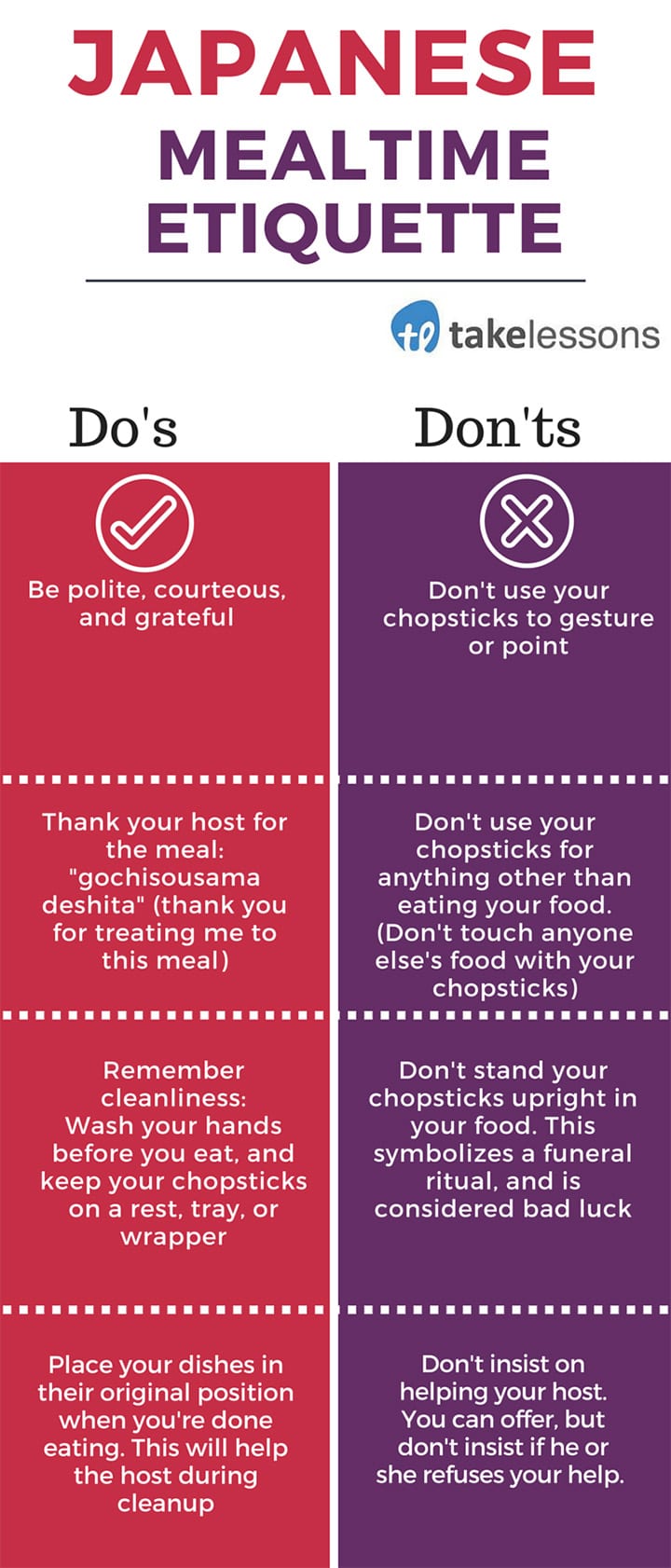There are a few important things you should know when you sit down to a Japanese meal. So whether you’re visiting Japan or joining some Japanese friends for dinner, learn some basic Japanese etiquette with language tutor Emily G…
Foreigners traveling to Japan often find themselves overwhelmed not only by the new sights and sounds, but also by the country’s unique etiquette. One of the most common places where foreigners encounter Japanese etiquette is during mealtime.
Japan’s culture is very different from American culture, but perhaps the biggest surprise is how the differences touch even the most mundane parts of our daily lives. Meals in Japan, for example, can be very different from the typical American eating experience.
If you plan to visit Japan, you may want to be aware of some of these differences. Here are some basic Japanese etiquette rules to keep in mind during meal times.
What is Proper Etiquette in Japan?
Mealtime in Japan is a time to relax and enjoy good food and company. There are a few basic etiquette rules that everyone should follow, in order to make the experience more enjoyable for everyone. Here are a few tips:
- Arrive on time. This shows respect for the host and ensures that the meal can start on time.
- Silence your phone. This is common courtesy everywhere, but especially important in Japan where meals are often seen as a time to connect with others and disconnect from technology.
- Wait to be seated. The host will usually indicate where you should sit, so it’s best to wait until they do so before sitting down.
- Don’t start eating until everyone has been served. Again, this is common courtesy, but important to remember in Japan where meals are often seen as a time for conversation and connection.
- Eat at a moderate pace. This shows respect for the chef and gives everyone a chance to enjoy the meal without feeling rushed.
- Thank the host when the meal is over. A simple “gochisousama deshita” (thank you for the meal) is sufficient.
Following these basic etiquette rules will help to ensure that everyone enjoys mealtime in Japan.
Of course, knowing how to communicate with your dinner partners is important everywhere – but especially in Japan, too! This video has some tips on how to communicate effectively in Japanese, but be sure to sign up for Japanese lessons for a more comprehensive overview:
https://www.youtube.com/watch?v=kTtW06_si80
What’s Considered Rude in Japan?
While the Japanese are generally considered to be very polite and welcoming people, there are still some things that can be considered rude in their culture.
For example, at dinnertime it is considered impolite to make noise while eating, and it is also considered bad manners to leave food on your plate.
Likewise, it is considered to be poor etiquette to enter someone’s home without taking off your shoes, and visitors are expected to sit on the floor instead of in chairs.
In general, the Japanese place a great deal of emphasis on politeness and respect, so it is always best to err on the side of caution when traveling to or interacting with people from this culture.
Japanese Eating Etiquette
Japanese eating etiquette is characterized by a number of unique customs and courtesies. By following these simple guidelines, you can enjoy a meal in Japan while showing respect for local customs.
1. What to Say
There are a few Japanese phrases you need to know in order to be polite during a meal. If you watch a lot of Japanese TV programs, you may already be familiar with some of these phrases.
Itadakimasu
Itadakimasu is a very polite way to say that you’re about to eat.
You can say this at the beginning of a meal.
Gochisousama deshita
Use this expression at the end of a meal to show your appreciation for the food.
The phrase comes from the word meaning to treat someone to something, like a meal, so you’re basically saying, “thank you for treating me to this meal.”
The more vocabulary you know, the more comfortable you will feel. Learn basic Japanese mealtime vocabulary here.
2. What to Do
Japanese people are very serious about cleanliness, so be sure to wash your hands before you eat.
If you’re using chopsticks, make sure to rest them on the chopstick rest, if one is provided, when they are not in use.
If there is no chopstick rest, place them on a tray or in a wrapper, this keeps the table and your chopsticks clean.
If you’re a student and you’re using disposable chopsticks, take a look at them after you break them apart. Some Japanese say that if your chopsticks break apart evenly, you’re sure to graduate!
3. What NOT to Do
Do not use your chopsticks for anything besides eating food from your plate or bowl.
Don’t use your chopsticks to gesture or point. Sometimes, we’re tempted to place food from the serving dishes onto our plates using our chopsticks, but you shouldn’t do this either.
A separate set of serving chopsticks should be provided. Again, this is a cleanliness issue. Japanese people are careful not to put anything they’ve used, such as their chopsticks, on other people’s food.
You should also be careful not to stand your chopsticks up in your food or place them on top of your plate or bowl. If you stab your chopsticks into your food or balance them on top of your plate, you may accidentally flip them!
Sticking your chopsticks upright in your rice looks like a common funeral ritual, and is considered bad luck.
4. Japanese Restaurant Etiquette
When eating at a Japanese restaurant, it is important to be mindful of a few key etiquette points.
First, it is considered rude to leave food on your plate, so be sure to finish everything on your dish.
Second, avoid making noise while you eat, such as slurping your soup or clicking your chopsticks together.
Third, try to avoid taking food from other people’s plates; if you would like to try something, ask the person next to you for permission first.
By following these simple etiquette guidelines, you can ensure that you have a pleasant and respectful dining experience.
5. Japanese Food Etiquette
Japanese cuisine is renowned for its delicate flavors and beautiful presentation. When dining in Japan, it is important to be aware of certain etiquette rules that will help you to enjoy the experience to the fullest.
For instance, it is considered rude to leave food on your plate, as it implies that you are not satisfied with the meal. It is also impolite to use your chopsticks to point at someone or to stick them upright in a bowl of rice. When ordering sushi, it is perfectly acceptable to eat it with your fingers.
However, if you are using chopsticks, be sure to use them correctly – never pass food from one set of chopsticks to another, as this is considered extremely bad manners.
By following these simple guidelines, you can ensure that your meal in Japan will be a pleasurable and memorable one.
Japanese Customs and Etiquette for Cleaning Up
Lastly, when you’re a guest, don’t insist on helping with anything. You can offer, but if your host refuses, do not insist. Japanese people believe in social debts and can feel insulted if someone insists on doing their job for them.
You can help the host by placing your dishes in their original position (where they were at the start of the meal), this means you’re done and makes clean up easier.
Just do your best to be polite and thank your host for the food; he or she will feel very appreciated.
SEE ALSO: The World’s Weirdest Food and Drink Superstitions
Japanese Dining Etiquette – Final Tips
Japanese people are very kind, and they generally understand that visitors may not know all of their customs. Just do your best to be polite and cleanly, and make sure you know how to say onegaishimasu お願いします(please), arigato ありがとう (thank you), and sumimasen すみません (pardon me).
Keep these Japanese etiquette rules in mind and you should have no problem getting through your Japanese meal!
Nevertheless, if you’re looking to travel to Japan or are just interested in their culture, it’s important to learn about their etiquette. While we’ve covered some of the basics here, there are many other intricacies to Japanese dining manners.
For a more comprehensive understanding and for hands-on practice, be sure to sign up for our Japanese lessons.
We hope that this article has provided you with an appreciation for the importance of etiquette in Japanese culture and given you a little taste of what it might be like to enjoy a meal in Japan.

Emily G. teaches Japanese, Latin, and Greek in Montgomery, TX. She has a Bachelor’s degree from Texas A&M University and a Master’s in Ancient History. Emily has been teaching since 2009. Learn more about Emily here!
Photo by sincerleykerbie
Maile Proctor

